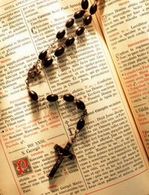 I still have my first set. Do you?
I still have my first set. Do you?
It
was given to me as a first communion gift: simple black beads with a plain
plastic cross. They’re small,
child-sized, but I carried them in May processions when I was in grade school. They served to teach me the rudiments
of one of our faith’s most popular – but often misunderstood – forms of prayer.
The
rosary.
Since
October is dedicated to this devotion, I thought it would be a good time to
remind ourselves how meaningful it is, and to appreciate even more the part it
plays in our Catholic culture.
Many
religions use beads to guide them in prayer, but the origins of the rosary are
still somewhat hazy.
I did a
little “Googling,” and found the following, from Fr. William Saunders at the
EWTN website:
The
use of “prayer beads” and the repeated recitation of prayers to aid
in meditation stem from the earliest days of the Church and has roots in
pre-Christian times. Evidence exists from the Middle Ages that strings of beads
were used to count Our Fathers and Hail Marys. Actually, these strings of beads
became known as “Paternosters,” the Latin for “Our Father.”
The structure of the rosary
gradually evolved between the 12th and 15th centuries. Eventually 50 Hail Marys
were recited and linked with verses of psalms or other phrases evoking the
lives of Jesus and Mary. During this time, this prayer form became known as the
rosarium (“rose garden”), actually a common term to designate a
collection of similar material, such as an anthology of stories on the same
subject or theme. During the 16th century, the structure of the five-decade
rosary based on the three sets of mysteries (Glorious, Sorrowful, Joyful)
prevailed.
Tradition does hold that St.
Dominic (d. 1221) devised the rosary as we know it. Moved by a vision of our
Blessed Mother, he preached the use of the rosary in his missionary work among
the Albigensians, who had denied the mystery of Christ. Some scholars take
exception to St. Dominic’s role in forming the rosary. The earliest accounts of
his life do not mention it, the Dominican constitutions do not link him with it
and contemporaneous portraits do not include it as a symbol to identify the
saint.
Elsewhere, I’ve read that the
rosary began as a practice by the laity to imitate the monastic Office (Liturgy
of the Hours), by which monks prayed the 150 Psalms. The laity, many of whom
could not read, substituted 50 or 150 Ave Marias for the Psalms. Sometimes a
cord with counters on it was used.
change several years ago, when Pope John Paul II elected to add a fourth set of
mysteries: the Luminous Mysteries, or Mysteries of Light. (Not everyone was thrilled, since this
disrupted the parallel of the beads with the psalms, but the faithful seem to
have accepted the change nonetheless.) You find rosaries today made of all kinds of
material, from cheap plastic to expensive gems. I remember vividly the rosaries worn by nuns: massive black
links that announced their approach with clack-clack-clack against black
cloth. Occasionally, a search on
Ebay will turn up unusual monastic rosaries that have three mysteries and 150
beads. They must weigh a ton.
a powerful source of inspiration and hope. I know in my own life it has brought calm in the midst
of many storms. This meditative
form of prayer just works.
wooden beads that I bought a few years ago at the Abbey of Gethsemani in Kentucky. But my fingers still remember the first
set I used – with deep affection and boundless gratitude. Who knows how many prayers were
answered or graces received from using those simple black beads?
ground me in the faith – faith, I’m reminded, that can be as close as my fingertips.
